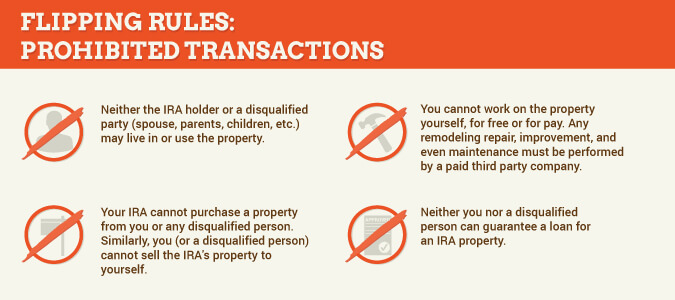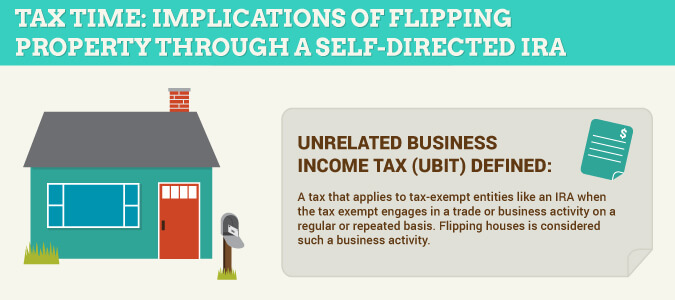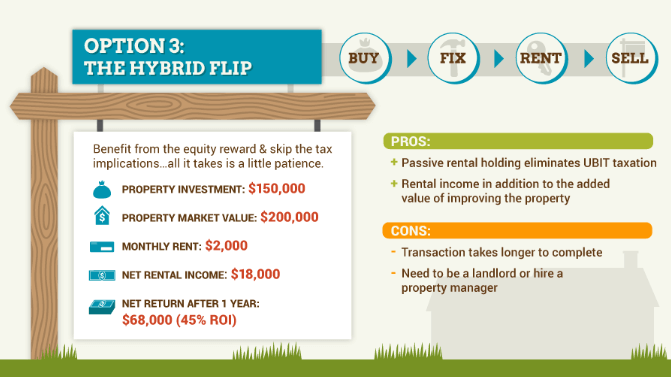Top Home Flipping Markets for 2016

One of the key factors driving growth in a number of the nation’s leading real estate markets is a lack of new construction. There are just not enough new housing units being built to keep up with demand from wave of millennial buyers who are ready and willing to purchase a move-in ready home thanks to a rebounding economy. As a result, home flipping has continued to be a solid investment option for real estate investors with a Self-Directed IRA or Solo 401(k).
A recent report released by RealtyTrac shows that home flipping transactions have reached a six-year high in the 2nd quarter of 2016, and that trends remain strong for this type of opportunity.
A Look at the Numbers
Following are some of the key data elements from the report:
- Home flips accounted for 5.5% of all homes sold in the 2nd quarter, up from 5.4% in Q2 of 2015.
- A total of 51,434 homes were flipped by 39,775 investors. The overall number is up 14% from the previous quarter, and the number of participants in the market represents a nine-year high dating back to 2007. These numbers include both institutional and individual investors.
- The average home flipped in the quarter sold for $189,000, which represents a 48.8% gross return based on an average initial purchase price of $127,000. The $62,000 average gross profit on these deals represents the highest level since the beginning of the data cycle in 2000, and a steady increase over the 47.5% average gross profit on flips in Q2 of 2015. As a key point of contrast, the average gross profit on flips in 2006 was just 27%.
- The most productive price range is for homes between $100,000 and $200,000, representing 35% of all flip transactions. The target home price appears to be shifting upwards, however, as the number homes in the $200,000 to $300,000 range that were flipped increased by 10% over a year ago.
- The average time to flip was 185 days. This represents a slight increase from the 180 day average in previous quarter.
Not mentioned in the report, but something we see as key to the continued strength of this opportunity is the solid availability of mortgage loans for retail homebuyers. Adding value to a property does you no good if you cannot sell, and the collapse of credit availability was what killed the flipping market in 2007-2008.
Top Markets
The RealtyTrac study identified the following as the top metropolitan markets for home flipping in 2016:
CityFlips as % of overall home salesMemphis, TN11.1%Visalia-Porterville, CA10.1%Tampa, FL10.0%York-Hanover, PA9.7%Mobile, AL9.6%Fresno, CA9.5%Lakeland-Winter Haven, FL9.5%Deltona-Daytona Beach-Ormond Beach, FL9.4%Clarksville, TN9.3%Miami, FL8.6%
Cash is King
While some credit is available for investors wanting to flip properties, 70% of flipped homes were purchased with cash. For investors using a self-directed retirement plan, this can be a big advantage. Most household savings are locked up in tax-sheltered retirement plans, and the ability to tap that source of capital for house flipping can present significant profit potential.
Seizing the Opportunity with your IRA or 401(k)
When putting your self-directed retirement plan funds to work in flipping, there are several things you need to consider to ensure you maximize the benefit to your savings while at the same time minimizing risk. This is a topic we covered in depth with a series of articles.
All plan transactions must be conducted at arm’s length and avoid disqualified parties. While you can identify opportunities and negotiate deals, and administer a plan transaction by signing contracts, paying for expenses and receiving income into the plan account, you cannot add value to the IRA through the provision of goods or services. Leave your tool kit at home when your IRA is flipping houses and hire unrelated professionals for all work.

Flipping houses is something the IRS considers a trade or business activity, unlike passive investments such as holding rentals or collecting interest. As such, a trust tax known as UBTI (Unrelated Business Taxable Income) applies to an IRA when it engages in such activities on a regular or repeated basis. The trust tax rates can be high, and this tax cost can put a significant dent in the overall return to your IRA. That said, one simply needs to keep their eye on the expected net, after-tax return to the IRA and compare that to other alternatives the IRA may have to generate income. If you can flip a house and generate 35% return before UBIT, that still represents a net return to the IRA in excess of 21%. What else is your IRA doing that earns that kind of return?

You can consider alternative approaches to put your Checkbook IRA or Solo 401(k) to work in the flip market, without having exposure to UBIT. If your plan lends money to another investor so that they can flip a house, the points and interest received by the IRA are passive income not subjected to taxation, for example. You can also execute what we refer to as a hybrid-flip, whereby the IRA purchases a property to fix up, but rather than immediately selling the property, holds it as a rental for at least a year. When the IRA sells in the future, this is no longer viewed as a flip, but rather as a reallocation out of passive real estate and into cash, with no tax implications. The added value of the flip is captured and represents a profit opportunity for your self-directed plan, but by delaying the sale, the tax burden is eliminated.

As a diversified investor with a self-directed IRA plan, it is important to understand the opportunities available in your specific market. For the last few years house flipping has been a prime choice, and that trend does not appear to be fading.
What our clients says about us
Quick answers to common questions
We’ll take you through a simple, step by step process designed to put your investment future into your own hands…immediately. Everything is handled on a turn-key basis. You take 100% control of your Retirement funds legally and without a taxable distribution.
YES! In 1974, Congress passed the Employee Retirement Income Security Act (ERISA) making IRA, 401(k) and other retirement plans possible. Only two types of investments are excluded under ERISA and IRS Codes: Life Insurance Contracts and Collectibles (art, jewelry, etc.). Everything else is fair game. IRS CodeSec. 401 IRC 408(a) (3)
It’s actually pretty simple. Early on, regulators let the securities industry take the lead in educating the public about retirement accounts. Naturally, brokers and banks promoted stocks, bonds, and mutual funds—giving the impression that those were the only allowed investments. That was never true... and still isn’t. You can probably guess why they kept the rest under wraps.
It is possible to use funds from most types of retirement accounts:
- Traditional IRA
- Roth IRA
- SEP IRA
- SIMPLE IRA
- Keogh
- 401(k)
- 403(b)
- Profit Sharing Plans
- Qualified Annuities
- Money Purchase Plans
- and many more.
It must be noted that most employer sponsored plans such as a 401(k) will not allow you to roll youraccount into a new Self-Directed IRA plan while you are still employed. However, some employers will allow you to roll a portion of your funds. The only way to be completely sure whether your funds are eligible for a rollover is by contacting your current 401(k) provider.
A Solo 401(k) requires a sponsoring employer in the format of an owner-only business. If you have a for-profit business activity – whether as your main income or as a side venture – and have no full-time employees other than potentially your spouse, your business may qualify. The business may be a sole-proprietorship, LLC, corporation or other entity type.
A self-directed retirement plan is a type of IRA or 401(k) that gives you greater control over how your retirement funds are invested. Unlike traditional accounts held at banks or brokerage firms that limit you to stocks, bonds, and mutual funds, self-directed plans allow you to invest in a wide range of alternative assets including real estate, private businesses, precious metals, cryptocurrency, and more.
These plans still follow the same IRS rules and maintain the same tax-deferred or tax-free benefits as conventional retirement accounts. The difference is simply in how and where you choose to invest.
No. Moving to a self-directed IRA or Solo 401(k) does not trigger any taxes, as long as your funds are eligible for rollover.
Self-directed retirement plans maintain the same tax-advantaged status as traditional plans offered by banks or brokerage firms. The key difference is flexibility—our plans are designed to give you greater control and allow for a wider range of alternative investments beyond stocks, bonds, and mutual funds.
A prohibited transaction is any action between your retirement plan and a disqualified person that violates IRS rules and can lead to serious tax consequences. Under IRS Code 4975(c)(1), prohibited transactions include:
- Selling or leasing property between your plan and a disqualified person Example: Your IRA cannot purchase a property you already own.
- Lending money or extending credit between the plan and a disqualified person Example: You cannot personally guarantee a loan your IRA uses to buy real estate.
- Providing goods or services between your plan and a disqualified person Example: You can’t use your personal furniture to furnish a rental property owned by your IRA.
- Using plan income or assets for the benefit of a disqualified person Example: Your IRA cannot buy a vacation home that you or your family use.
- Self-dealing by a fiduciary (using plan assets for their own benefit) Example: Your CPA shouldn't loan your IRA money if they’re advising the plan.
- Receiving personal benefit from a deal involving your IRA's assets Example: You can’t pay yourself from profits your IRA earns on a rental.
If a transaction doesn’t clearly fall within the allowed guidelines, the IRS or Department of Labor may review the situation to determine if it qualifies as a prohibited transaction.
Disqualified persons are individuals or entities that are prohibited from engaging in certain transactions with your IRA or 401(k). Doing so could trigger a prohibited transaction, which may result in taxes and penalties.
Here’s who is considered a disqualified person:
- You (the account holder)
- Your spouse
- Your parents, grandparents, and other ancestors
- Your children, grandchildren, and their spouses
- Any advisor or fiduciary to the plan
- Any business or entity owned 50% or more by you or another disqualified person, or where you have decision-making authority
These rules exist to prevent self-dealing and ensure your retirement plan remains in compliance with IRS regulations.
(Reference: IRC 4975)
Understanding and following these rules can be tricky, but it’s very doable. The best way to stay compliant is to work with professionals who specialize in self-directed retirement plans. They can help you navigate IRS guidelines and avoid prohibited transactions.
If an IRA holder is found to have engaged in a prohibited transaction with IRA funds, it will result in a distribution of the IRA. The taxes and penalties are severe and are applicable to all of the IRA’s assets on the first day of the year in which the prohibited transaction occurred.
Yes. While self-directed retirement plans allow for a wide range of investments, there are a few important restrictions.
You cannot invest in collectibles or life insurance contracts, and you must avoid prohibited transactions—activities that benefit you personally rather than the retirement plan. These include things like buying or selling property to yourself or family members, using plan assets for personal gain, or self-dealing in any way.
Violating these rules could cause your entire IRA to lose its tax-advantaged status. To protect your account, it’s essential to work with professionals who understand IRS regulations and can help you stay compliant.
This is a common misconception. In many cases, professionals may simply be unfamiliar with self-directed retirement plans, as they fall outside their usual scope of work. CPAs and tax preparers are trained to file taxes, not necessarily to advise on alternative retirement strategies. Financial advisors and brokers often work for firms that focus on traditional investments like stocks and mutual funds—and may not benefit from or support alternative options like real estate or private lending.
Self-directed retirement investing is legal under IRS rules—but like any specialized area, it requires working with professionals who understand how it works.
The IRS has rules in place to make sure your IRA is used only for the exclusive benefit of the retirement account—not for personal gain or to help family members. These rules can get complicated because there are many ways a conflict of interest can occur, even unintentionally.
For example, if your IRA buys a house and rents it to your mother, you might be reluctant to evict her if she stops paying rent. That emotional connection creates a conflict between what’s best for your IRA and your personal relationships, something the IRS aims to prevent.
These rules help ensure your retirement account stays compliant and protected. (See IRC 408)
Yes. Most tax-deferred retirement accounts—such as Traditional IRAs, old 401(k)s, 403(b)s, and TSPs—can be rolled over into a self-directed IRA or Solo 401(k), depending on your eligibility. Roth IRAs cannot be rolled into these accounts.
You can contribute directly from earned income, subject to annual IRS contribution limits. The method and amount depend on the type of plan you have (e.g., Solo 401(k) vs. IRA).
To take a distribution, you'll request funds through your custodian or plan administrator. Distributions may be taxable depending on your account type and age. Early withdrawals may be subject to penalties.
For 2025, the Solo 401(k) max contribution limit is $81,250 if age 60-63, $77,500 if age 50-59 or 69+, and $70,000 if under 50. Traditional and Roth IRAs have a limit of $7,000 ($8,000 if age 50+). Limits are subject to IRS adjustments.
Yes. IRA contributions are typically due by your personal tax filing deadline (e.g., April 15). Solo 401(k) contributions follow your business tax filing deadline, including extensions.
IRS reporting requirements vary depending on the type of self-directed retirement plan you have. Here’s a quick breakdown of what you need to know
Please note: Our team can help you understand what’s required for your specific account, but we don’t provide tax or legal advice. We always recommend working with a qualified tax professional to ensure full IRS compliance.
Self-Directed IRA (Traditional or Roth)
- Form 5498 – Filed by your custodian each year to report contributions, rollovers, and the fair market value (FMV) of your account.
- Form 1099-R – Issued if you take a distribution or move funds out of your IRA.
- Annual Valuation – You'll need to provide updated FMV for any alternative assets held in the account, such as real estate or private placements.
Solo 401(k)
- Form 5500-EZ – Required if your plan assets exceed $250,000 as of year-end. Must be filed annually by the plan participant.
- Form 1099-R – Required if you take a distribution or roll funds out of the plan.
- Contribution Tracking – Keep records of employee and employer contributions. These are not filed with the IRS but may be needed for tax reporting or audits.
SEP IRA
- Form 5498 – Filed by your custodian to report contributions and FMV.
- Form 1099-R – Filed by your custodian. Issued for any distributions.
- Employer Contributions – Must be reported on your business tax return (and on employee W-2s, if applicable).
Health Savings Account (HSA)
- Form 5498-SA – Filed by your HSA custodian to report contributions.
- Form 1099-SA – Filed by your HAS custodian. Issued for any distributions.
- Form 8889 – Must be included with your personal tax return to report contributions, distributions, and how funds were used.







